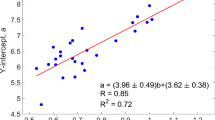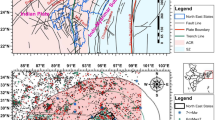Abstract
It is a common practice to describe the activity of a seismogenic source using Gutenberg–Richter magnitude–frequency relation. The use of this relation includes the statistical determination of three parameters, two of which will be discussed in this paper: the exceedance rate of a threshold magnitude and the rate of decay of the exceedance rate with magnitude. The third parameter, M max , which defines the maximum assumed magnitude, will not be treated here. Due to the methods used to estimate the values of these parameters under certain circumstances, their statistical estimators turn out to be correlated. In this paper we explore: (1) the impact of this correlation on seismic hazard for some simple, canonical cases; and (2) practical ways in which this correlation can be propagated through the seismic hazard calculations. We conclude that the impact of correlation on seismic hazard estimates is moderate and that ignoring correlation is frequently a conservative decision. Also, we propose a way in which correlation can be propagated into seismic hazard calculations within the framework of logic trees.













Similar content being viewed by others
References
Aki K (1965) Maximum likelihood estimate of b in the formula logN = a − bM and its confidence limits. Bull Earthq Res Inst Tokyo Univ 43:237–239
Bengoubou-Valérius M, Gilbert D (2012) Bootstrap determination of the reliability of b-values: an assessment of statistical estimators with synthetic magnitude series. Nat Hazards. https://doi.org/10.1007/s11069-012-0376-1
Coppersmith K, Youngs R, Sprecher C (2009) Methodology and main results of seismic source characterization for the PEGASOS Project, Switzerland. Swiss J. Geosci 102:91–105
Johnston A (1994) Seismotectonic interpretation and conclusions from the stable continental region seismicity database. In: The earthquakes of stable continental regions, vol 1, Assessment of large earthquake potential. Technical report TR-102261V1, Electric Power Research Institute (EPRI), Palo Alto, CA
Kijko A, Sellevoll MA (1992) Estimation of earthquake hazard parameters from incomplete data files. Part ii. Incorporation of magnitude heterogeneity. Bull Seismol Soc Am 82:120–134
Kijko A, Smit A (2012) Extension of the Aki-Utsu b-value estimator for incomplete catalogs. Bull Seismol Soc Am 102(3):1283–1287. https://doi.org/10.1785/0120110226
Marzocchi W, Sandri L (2003) A review and new insights on the estimation of the b-value and its uncertainty. Ann Geophys 46:1271–1282
Musson R, Sellami S, Brüstle W (2009) Preparing a seismic hazard model for Switzerland: the view from PEGASOS Expert Group 3. Swiss J Geosci 102:107–120
Ordaz M (1988) On the use of probability concentrations. Struct Saf 5:317–318
Rosenblueth E (1981) Two point estimates in probability. Appl Math Model 5:329–335
Savy J-B, Boissonnade A, Mensing R, Short C (1993) Eastern U.S. seismic hazard characterization update. Report UCRL-ID-l15111, Lawrence Livermore National Laboratory, California
Stromeyer D, Grünthal G (2015) Capturing the uncertainty of seismic activity rates in probabilistic seismic-hazard assessments. Bull Seismol Soc Am 105:580–589
Utsu T (1965) A method for determining the value of b in the formula log n = a − bM showing the magnitude–frequency relation for earthquakes. Geophys Bull Hokkaido Univ 13:99–103 (in Japanese with English summary)
Weichert DH (1980) Estimation of the earthquake recurrence parameters for unequal observation periods for different magnitudes. Bull Seismol Soc Am 70(4):1337–1346
Acknowledgements
Authors are grateful to Professor J. Bommer for his many comments and suggestions, which improved considerably the original manuscript.
Author information
Authors and Affiliations
Corresponding author
Rights and permissions
About this article
Cite this article
Ordaz, M., Faccioli, E. Modelling correlation between Gutenberg–Richter parameters a and b in PSHA. Bull Earthquake Eng 16, 1829–1846 (2018). https://doi.org/10.1007/s10518-017-0274-8
Received:
Accepted:
Published:
Issue Date:
DOI: https://doi.org/10.1007/s10518-017-0274-8




